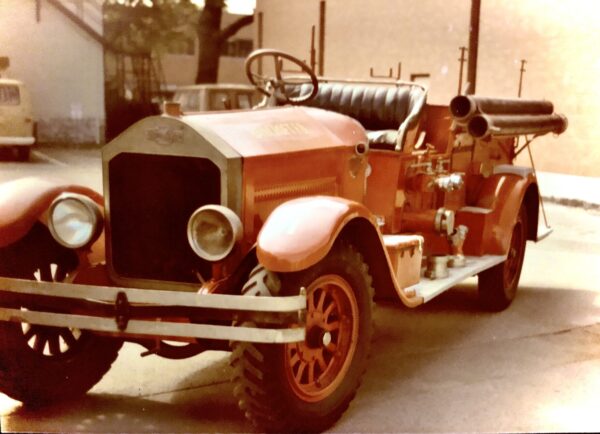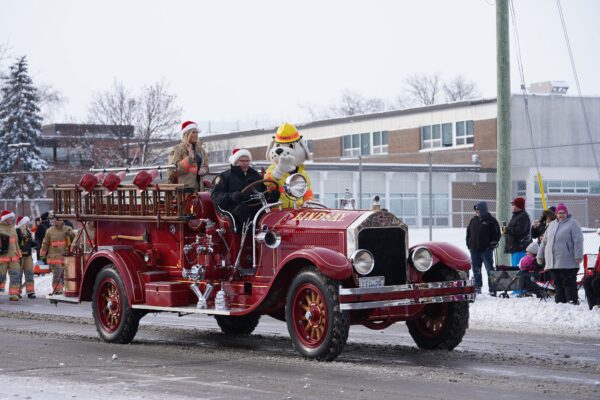Resplendent in red: The story of Lindsay’s American LaFrance fire engine

Night owls in the Reaboro area might have known something was up when they gazed through their windows around 11:30 p.m. on Monday April 5, 1954. Clattering down the dirt road in front of them was a flamboyant-looking fire engine with pair of huge headlights cutting through the inky darkness. The driver opened up its throttle, giving the truck all the power its ancient six cylinder engine could muster as it turned into the lane of Kenneth Reid’s farm. Reid’s barn and hen house were on fire, and half a dozen firefighters had been dispatched from Lindsay to quell the flames.
As the fire brigade quickly and efficiently ran two lengths of hose to a nearby creek and hooked them up to the truck, nosy neighbours who may have gathered to watch might have scratched their heads in puzzlement. Why was a 25-year-old vehicle being sent out into the countryside when surely newer, faster, and more efficient equipment could do the job?
Back in Lindsay, local politicians would soon be peppering the fire chief with questions about why this particular truck was being driven into the depths of Ops Township when its reliability had already been called into question. Indeed, the previous June, a local alderman had informed Lindsay’s council that, while pumping water for a structural fire on Kent Street, the truck “almost shook itself to pieces in front of the Olympia, shooting oil all over the place.”
From being an object of scorn some seven decades ago to leading local parades in our own time, the 1929 American LaFrance pumper truck that was purchased by the Town of Lindsay 95 years ago has had quite a life. Top-of-the-line in firefighting technology when it arrived on the scene, it later became a symbol of pre-amalgamation politics and is now one of Lindsay’s most recognizable icons.
The LaFrance wasn’t Lindsay’s first piece of firefighting equipment. In 1861, not long after a devastating fire consumed much of Kent Street, the town purchased a horse-drawn pumping engine from the William Perry firm, of Montreal. Though a new fire hall opened in 1901, horse-drawn fire apparatus would remain the norm in Lindsay well into the 1920s.

But this would soon change. As early as 1927, representatives of American LaFrance were making presentations to council about the merits of their company’s products. Not until Oct. 17, 1929, though, would local citizens and their elected representatives have an opportunity to see a new truck in action. “In one test, four streams [of water] were thrown, the total discharge being 1330 gallons per minute and the streams were strong enough to go over any building on Kent Street,” noted the Lindsay Daily Post admiringly in its reportage the following day.
American LaFrance had won council over, and a purchase was formally ratified on Jan. 21, 1930. Assistant Fire Chief Ross McArthur drove the new truck – which cost a little more than $15,000 – from Toronto to Lindsay over the course of two days, navigating bad roads with apparently little trouble. With the word “Lindsay” emblazoned across its scarlet hood and its nickel trim all polished up, it was ready for action – but not before being proudly displayed in the Victoria Park Armoury for the Picadilly Circus (a fundraising event organized by the Kiwanis Club) later that month.
For the next 28 years, the “LaFrance Foamite” (as this particular truck was branded) served as Lindsay’s principal piece of firefighting equipment. It was summoned to fires not only in Lindsay, but also farther afield, including Kinmount and Sunderland – a practice that came to symbolize the challenges of sharing wealth and responsibility between the Town of Lindsay and the surrounding townships. As early as 1931, the Victoria County Council refused to provide Lindsay with a grant to cover the costs of taking the truck to out-of-town calls. This prompted the town council to charge a flat rate of $200 for every time the LaFrance was required for these occasions.
By the second half of the 1950s, the LaFrance – now joined by other trucks – was starting to show its age, and concerns were raised about what might happen should a fire occur while it was out of commission (as indeed it was for five weeks in 1953, when laid up for repairs). On April 8, 1958, a young boy drowned in the flooded underpass at the Lindsay fairgrounds, and the LaFrance was summoned to pump out the water. This would be one of the final calls for the old fire engine. That autumn, it was sold to the town of Maynooth for use at its fire department.
Although the Lions Club in Maynooth had purchased the truck, it soon discovered that the community was unable to store it properly. The truck became something of an embarrassment, and was sent back to Lindsay, which refused to accept it. As of 1963, the LaFrance was on the roster of Bancroft’s fire department, and a decade later it was acquired by a Brockville antique dealer. That’s where the late Ray Procter, a Lindsay firefighter, unearthed it in 1983 and facilitated a ground-up restoration.
Since then, the dazzling old LaFrance pumper has heralded the start of almost every Lindsay parade – while simultaneously raising awareness about fire prevention.





